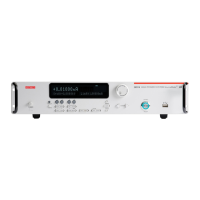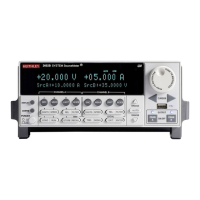2-4
SECTION 2
Two-terminal Device Tests
For example, assume that you measured a leakage current of 25nA
with a test voltage of 100V. The leakage resistance is simply:
R =100/25nA = 4GW (4 × 10
9
W)
2.4.3 Measurement Considerations
After the voltage is applied to the capacitor, the device must be
allowed to charge fully before the current measurement can be
made. Otherwise, an erroneous current, with a much higher
value, will be measured. The time period during which the capac-
itor charges is often termed the “soak” time. A typical soak time is
seven time constants, or 7RC, which would allow settling to less
than 0.1% of final value. For example, if R is 1MW, and C is 1µF,
the recommended soak time is seven seconds. With small leakage
currents (<1nA), it may be necessary to use a fixed measurement
range instead of auto ranging.
2.4.4 Example Program 2:
Capacitor Leakage Test
Program 2 performs the capacitor leakage test described above.
Follow the steps that follow to run the test using this program.
WARNING
Hazardous voltage may be present on the capacitor
leads after running this test. Discharge the capac-
itor before removing it from the test fixture.
With the power off, connect the instrument to the computer’s 1.
IEEE-488 interface.
Connect the test fixture to the instrument using appropriate 2.
cables.
Turn on the instrument, and allow the unit to warm up for 3.
two hours for rated accuracy.
Turn on the computer and start Test Script Builder (TSB). Once 4.
the program has started, open a session by connecting to the
instrument. For details on how to use TSB, see the Series 2600
Reference Manual.
You can simply copy and paste the code from Appendix A in 5.
this guide into the TSB script editing window (Program 2),
manually enter the code from the appendix, or import the TSP
file ‘Cap_Leak.tsp’ after downloading it to your PC.
If your computer is currently connected to the Internet, you
can click on this link to begin downloading: http://www.
keithley.com/data?asset=50927.
Discharge and install the capacitor being tested, along with 6.
the series resistor, in the appropriate axial component sockets
of the test fixture.
WARNING
Care should be taken when discharging the capac-
itor, as the voltage present may represent a shock
hazard!
Now, we must send the code to the instrument. The simplest 7.
method is to right-click in the open script window of TSB,
and select ‘Run as TSP file’. This will compile the code and
place it in the volatile run-time memory of the instrument.
To store the program in non-volatile memory, see the “TSP
Programming Fundamentals” section of the Series 2600 Refer-
ence Manual.
Once the code has been placed in the instrument run-time 8.
memory, we can run it at any time simply by calling the func-
tion ‘
Cap _ L eak()
’. This can be done by typing the text
‘
Cap _ L eak()
’ after the active prompt in the Instrument
Console line of TSB.
In the program ‘9. Cap_Leak.tsp’, the function
Cap _
Leak(vsrc)
is created. The variable
vsrc
represents the
test voltage value applied to the device-under-test (DUT). If
it is left blank, the function will use the default value given
to the variable, but you can specify what voltage is applied
by simply sending a voltage that is in-range in the function
call. As an example, if you wanted to source 100V, simply send
Cap _ L eak(100)
to the instrument.
The instrument will then source the programmed voltage and 10.
measure the respective current through the capacitor. The
measured current leakage and calculated resistance value will
then be displayed in the Instrument Console window of TSB.
NOTE
The capacitor should be fully discharged before run-
ning the test. This can be accomplished by sourcing 0V
on the device for the soak time or by shorting the leads
together. Care should be taken because some capacitors
can hold a charge for a significant period of time and
could pose an electrocution risk.
The soak time, denoted in the code as the variable
l _ soak
,
has a default value of 10s. When entering the soak time, choose
a value of at least 7RC to allow settling to within 0.1% of final
value. At very low currents (<500fA), a longer settling time may
be required to compensate for dielectric absorption, especially at
high voltages.
2.4.5 Typical Program 2 Results
As pointed out earlier, the exact value of leakage current will
depend on the capacitor value as well as the dielectric. A typical
value obtained for 1µF aluminum electrolytic capacitor was about
80nA at 25V.

